Kimberly V. Althage – December 2, 2021
Gateway Classic Cars is excited to present this 1929 Ford Model A Sedan in our St. Louis Showroom. Although it has been given some tasteful modifications, the classy Model A look remains unaltered.
A welcome relief since many Model A vehicles are chopped when hot rodding enthusiasts get their hands on them. Before going mainstream after World War II — a hopped-up car was a gow job until later, when the term “hot rod” was coined. Also colloquially called the A-Model Ford, the A, or A-bone among hot rodders and customizers, the Ford Model A has significance in automotive history.
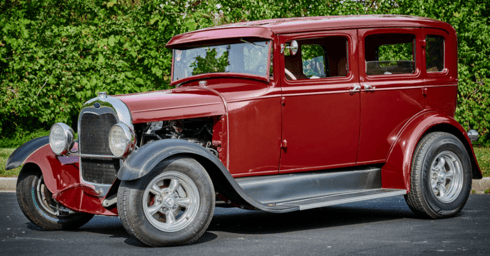
Ford Motor Company dominated the automotive market through the early 20s with its Model T. Yet, by the close of 1924, this dominance eroded. The Model T was being outclassed by more sophisticated competing brands who offered more style, better performing and more powerful engines, and improved amenities or cosmetic customization. Also, features Henry Ford considered to be unnecessary were gradually shifting in the public’s perception from luxuries to essentials.
The Model T vehicles still had manual cranking ignitions until 1919. They had mechanical brakes, an antiquated transmission, a relatively unchanged 22.5 hp engine from its introduction in 1908, and a more simple or Spartan interior. The competition was capitalizing on changing consumer tastes and their fatter budgets affording them extras in style and luxuries.
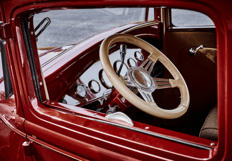
Despite the Model T’s decline in sales and Edsel Ford’s pleas, Henry Ford remained reluctant. Model T sales peaked at 1.8 million in 1923. Regardless of the face-lift and a greater choice of color palette in 1926, sales continued to slide. As successful as the Model T was, even Henry Ford realized it had overstayed its welcome. Edsel Ford finally prevailed, and it was one of his few victories over his headstrong father. The final Model T was driven off the assembly line by Henry and Edsel Ford and was commemorated with a ceremony and a secretive telegram to dealers on May 26, 1927. After producing more than 15 million Model T’s, an incredible era in automotive history had ended. Ford Motor Co. closed plants worldwide awaiting the go-ahead to retool for the car.
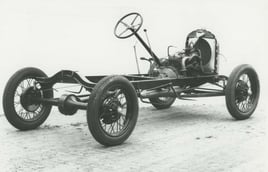 Henry Ford insisted that the Model T’s successor would be the finest car ever built and assured mechanical quality and reliability. In late 1926 Henry Ford directed his engineers to start work on a new four-cylinder engine, a new transmission, an innovative electrical system, and a new Ford chassis. Henry Ford focused on the mechanical aspects. Henry left the styling to a team led by his son Edsel due to his disdain for “cosmetic vanity” in automobiles.
Henry Ford insisted that the Model T’s successor would be the finest car ever built and assured mechanical quality and reliability. In late 1926 Henry Ford directed his engineers to start work on a new four-cylinder engine, a new transmission, an innovative electrical system, and a new Ford chassis. Henry Ford focused on the mechanical aspects. Henry left the styling to a team led by his son Edsel due to his disdain for “cosmetic vanity” in automobiles.Edsel Ford showed more interest in flashier automobiles; therefore, he was put in charge of the styling for the new build. He tapped into the expertise acquired when Ford Motor Co. purchased Lincoln. The New Ford was lower and sleeker than the Model T. It had beautiful bodylines directly influence by Edsel Ford’s styling ideas. To gain an advantage over the competition, he also pushed for more innovation like four-wheel mechanical brakes and a sliding-gear transmission in addition to his styling updates.
The public eagerly awaited as the ‘New Ford’ was developed. It became one of the year’s hottest news stories, in a year with many big news stories: 1927 marked the first transatlantic telephone call from NYC to London, the year the first feature-length “talkie” film hit theaters, and when Charles Lindbergh took his solo flight across the Atlantic. Reporters speculated about what the automaker would introduce, and cartoonists and illustrators made graphics of their speculations.
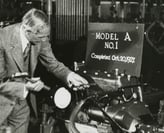
Early spy photographers made every effort to get pictures of the car, which proved difficult since Ford was careful to limit testing on public roads. Only the Automotive Daily News and the Brighton Argus succeeded in capturing any images of the secret, still unnamed Model A. Only once Henry and Edsel Ford were caught behind the wheel of a prototype, and Lawrence Sheldrick (engine and chassis engineer) was nearly mobbed by curious onlookers.
After many months devoted to the new design, plant retooling, and the new manufacturing methods that kept Ford’s ability to sell at a price point within anyone’s reach, the first ‘New Ford’ engine was completed by Henry for a photo op on October 20, 1927. The still-unnamed Ford automobile made its public debut 94 years ago on this date (Dec 2, 1927). It was considered the most significant vehicle introduction in automotive history and was an immediate hit. Crowds gathered in such large numbers it caused many cities to hire additional police to help direct traffic. Overall, it has been estimated some 25 million people came to view the vehicle that first week.
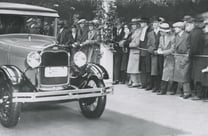 The public was correct to be so curious. It was perhaps the most important event for an industry that was reshaping American life. The changeover from the Model T to the Model A was historically the largest and most costly undertaking at the time with estimated cost between $100 million and $250 million. The car that symbolized the industry in the states and accounted for nearly 50% of sales in its 19-year lifespan was gone. What came after brought Ford Motor Company into the modern automobile world, marking its beginning of product development, and securing its legacy. Henry Ford stated the car was so new and different they would “wipe the slate clean and start all over again” and he officially gave ‘Model A’ its name.
The public was correct to be so curious. It was perhaps the most important event for an industry that was reshaping American life. The changeover from the Model T to the Model A was historically the largest and most costly undertaking at the time with estimated cost between $100 million and $250 million. The car that symbolized the industry in the states and accounted for nearly 50% of sales in its 19-year lifespan was gone. What came after brought Ford Motor Company into the modern automobile world, marking its beginning of product development, and securing its legacy. Henry Ford stated the car was so new and different they would “wipe the slate clean and start all over again” and he officially gave ‘Model A’ its name.The new Model A was more mechanically advanced and more sophisticated in style than its predecessor, and it was a big hit with buyers. Ford advertised the ”beautiful body lines” and the ”remarkable acceleration” of the Model A. Henry closed his introductory statement to dealerships with “At present I can only say this about the new model – it has speed, style, flexibility and control in traffic. There is nothing quite like it in quality and price.”
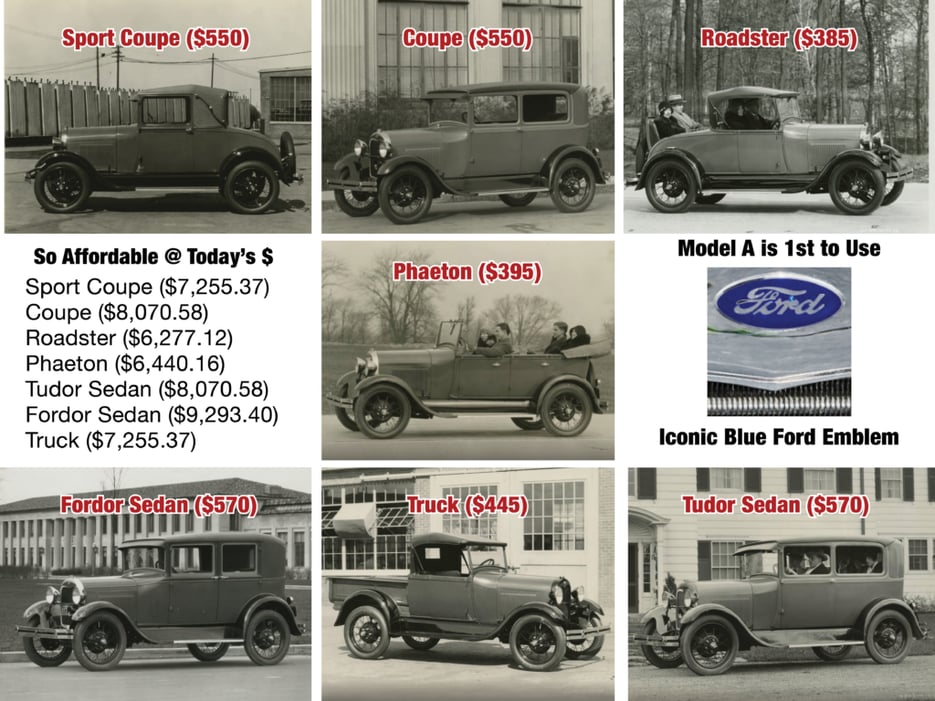
Ford’s Model A was an automotive pioneer. Many vehicles we drive today have components that originated from this car. It was the first Ford to use the standard conventional clutch and brake pedals, throttle, and gear shift. It was powered by a water-cooled L-head inline four with a displacement of 200.5-cu.in. (3.3 l) engine rated at 40 horsepower and had a top speed of 65 mph. It also featured four-wheel mechanical drum brakes, hydraulic shock absorbers, extensive use of anti-friction ball and roller bearings, and a Triplex shatter-proof glass windshield.
The Model A was the first low-priced car to have safety glass in the windshield. It could take a 50% harder impact before breaking than plate glass of equal thickness. It reduced dangers of flying glass, saving many lives, and preventing additional injuries in automobile accidents. This addition is recognized as one of the greatest contributions to safety since the induction of four-wheel brakes.
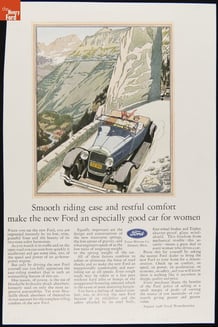 Ford like many automakers realized even then women often have the final say in car-buying decisions. Like this ad in the August 1928 issue of ‘Good Housekeeping’ Ford promoted the vehicle’s easy-riding comfort thanks to the anti-friction ball and roller bearings and its Houdaille hydraulic shock absorbers (formerly only used on more expensive automobiles). Ford touted its overall safety features and freedom from mechanical troubles to women drivers. Advertisements like this boasted its reliability on the road as “mental comfort” or a sense of security for these drivers. Women were assured a Model A was built to endure–to serve faithfully and well for many thousands of miles.
Ford like many automakers realized even then women often have the final say in car-buying decisions. Like this ad in the August 1928 issue of ‘Good Housekeeping’ Ford promoted the vehicle’s easy-riding comfort thanks to the anti-friction ball and roller bearings and its Houdaille hydraulic shock absorbers (formerly only used on more expensive automobiles). Ford touted its overall safety features and freedom from mechanical troubles to women drivers. Advertisements like this boasted its reliability on the road as “mental comfort” or a sense of security for these drivers. Women were assured a Model A was built to endure–to serve faithfully and well for many thousands of miles.The Model A was an immediate success. With seven body types offered at its launch, production reached 820,000 that first year. By February 4,1929, sales hit one million and then two million by July of the same year. Even songs were written and summed up its success. A Model A chassis was used to build a snowmobile for Admiral Byrd’s Antarctic Expedition, and with Ike Trone behind the wheel a Model A won one of the first known organized amateur speed trials held at Muroc in 1931.
It was such a commercial success the Model A allowed Ford to recapture sales leadership from Chevrolet. Its success was second only to its more famous predecessor, the Model T. Yet, as triumphant as it was, it was short-lived and unable to sustain Ford through the Depression. Model A production ended in March 1932, after 4.8 million of all body types were produced. It is most notable for helping Ford transition from pioneer to modern automaker.
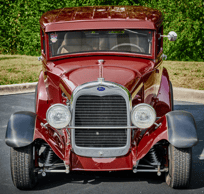
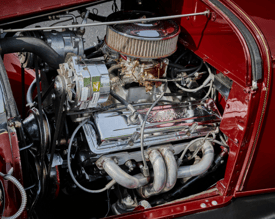
This little piece of significant historical relevance will not last long. If you would like to own your own piece of American history, please give our professional staff at the St. Louis Showroom a call. They will be happy to answer any questions you may have about this beauty. Gateway Classic Cars sells and consigns hundreds of vehicles each month. Do you have a classic car for sale with a story to tell? We’d love to hear about it, please email us at news@gatewayclassiccars.com to share it.
Historical Photos from The Henry Ford Digital Resources Collection — Pictures have link to Artifact’s Record — Model A Collage Artifact Links: Sport Coupe, Coupe, Roadster, Phaeton, Fordor Sedan, Truck, Tudor Sedan, & Ford Emblem.

Comments